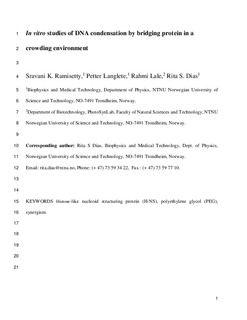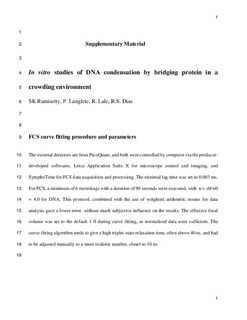| dc.contributor.author | Ramisetty, Sravani Keerthi | |
| dc.contributor.author | Langlete, Petter | |
| dc.contributor.author | Lale, Rahmi | |
| dc.contributor.author | Dias, Rita de Sousa | |
| dc.date.accessioned | 2017-12-08T09:36:24Z | |
| dc.date.available | 2017-12-08T09:36:24Z | |
| dc.date.created | 2017-10-19T10:39:45Z | |
| dc.date.issued | 2017 | |
| dc.identifier.citation | International Journal of Biological Macromolecules. 2017, 103 845-853. | nb_NO |
| dc.identifier.issn | 0141-8130 | |
| dc.identifier.uri | http://hdl.handle.net/11250/2469697 | |
| dc.description.abstract | The macromolecules of the bacterial cell occupy 20–40% of the total cytosol volume, and crowded environments have long been known to compact and stabilize DNA. Nevertheless, investigations on DNA-protein binding are generally performed in the absence of crowding, which may yield an incomplete understanding of how nucleoid-assembling proteins work. A family of such proteins, abundant in Gram-negative bacteria, is the histone-like nucleoid structuring proteins (H-NS). Herein, the synergistic role of macromolecular crowding (mimicked using polyethylene glycol, PEG) and H-NS was investigated using fluorescence correlation spectroscopy (FCS) and enzyme protection assays. We show that crowding enhances the binding of H-NS to the AT-rich tracks of the DNA, where it preferentially binds to, protecting these tracks towards enzyme digestion, inducing some DNA condensation, and inhibiting the biological function of DNA. We further suggest that the looping of DNA chains, induced by H-NS, contributes to the synergistic effect of DNA-binding protein and crowding agents, on DNA condensation. | nb_NO |
| dc.language.iso | eng | nb_NO |
| dc.publisher | Elsevier | nb_NO |
| dc.rights | Attribution-NonCommercial-NoDerivatives 4.0 Internasjonal | * |
| dc.rights.uri | http://creativecommons.org/licenses/by-nc-nd/4.0/deed.no | * |
| dc.title | In vitro studies of DNA condensation by bridging protein in a crowding environment | nb_NO |
| dc.type | Journal article | nb_NO |
| dc.type | Peer reviewed | nb_NO |
| dc.description.version | acceptedVersion | nb_NO |
| dc.source.pagenumber | 845-853 | nb_NO |
| dc.source.volume | 103 | nb_NO |
| dc.source.journal | International Journal of Biological Macromolecules | nb_NO |
| dc.identifier.doi | 10.1016/j.ijbiomac.2017.05.079 | |
| dc.identifier.cristin | 1505818 | |
| dc.description.localcode | © 2017. This is the authors’ accepted and refereed manuscript to the article. LOCKED until 20.5.2018 due to copyright restrictions. This manuscript version is made available under the CC-BY-NC-ND 4.0 license http://creativecommons.org/licenses/by-nc-nd/4.0/ | nb_NO |
| cristin.unitcode | 194,66,20,0 | |
| cristin.unitcode | 194,66,15,0 | |
| cristin.unitname | Institutt for fysikk | |
| cristin.unitname | Institutt for bioteknologi og matvitenskap | |
| cristin.ispublished | true | |
| cristin.fulltext | postprint | |
| cristin.qualitycode | 1 | |


